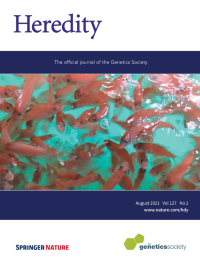View Item
- xmlui.general.dspace_homeCentros e Institutos de InvestigaciónCIRN. Centro de Investigaciones de Recursos NaturalesInstituto de Recursos BiológicosArtículos científicosxmlui.ArtifactBrowser.ItemViewer.trail
- DSpace Home
- Centros e Institutos de Investigación
- CIRN. Centro de Investigaciones de Recursos Naturales
- Instituto de Recursos Biológicos
- Artículos científicos
- View Item
Single - step genomic prediction of Eucalyptus dunnii using different identity by descent and identity by state relation ship matrices
Abstract
Eucalyptus L’Hér. (Myrtaceae) is the most valuable and globally planted forest tree genus. Fast growth, adaptability to a broad diversity of tropical and subtropical regions, combined with versatile wood properties for energy, solid products, pulp, and paper have warranted their outstanding position in current world forestry (de Lima et al. 2019). Eucalyptus dunnii Maiden (hereafter E. dunnii) has become increasingly used in commercial afforestation due
[ver mas...]
Eucalyptus L’Hér. (Myrtaceae) is the most valuable and globally planted forest tree genus. Fast growth, adaptability to a broad diversity of tropical and subtropical regions, combined with versatile wood properties for energy, solid products, pulp, and paper have warranted their outstanding position in current world forestry (de Lima et al. 2019). Eucalyptus dunnii Maiden (hereafter E. dunnii) has become increasingly used in commercial afforestation due to its combined good performance for growth, stem straightness, and frost tolerance, together with suitable wood density and pulp yield.
In a broad sense, genomic selection (GS) is a family of statistical methods developed for predicting the breeding values of nonphenotyped individuals with the assistance of a large number of molecular markers widespread distributed throughout the genome (Meuwissen et al. 2001). These methods exploit cosegregation between markers and quantitative trait loci (QTL) in linkage disequilibrium (LD). In forest trees, GS is of particular benefit due to the extended breeding cycles caused by delayed reproductive maturity and the need for early selection of traits that express late in life (Mphahlele et al. 2020). In this context, GS has a potentially substantial impact on the rate of genetic gain by increasing the intensity and accuracy of selection and, particularly, by shortening the generational interval (Grattapaglia et al. 2018).
The genomic best linear unbiased prediction (GBLUP) is one of the most commonly GS methods. It is basically a variant of the standard BLUP method (hereafter ABLUP, cf. Henderson 1984), where the pedigree-based numerator relationship matrix (Amatrix) is replaced by a genomic relationship matrix (G-matrix, e.g., Habier et al. 2013). Many empirical studies with forest tree species have shown that GBLUP is a very promising approach for tree breeding (e.g., Mphahlele et al. 2020; Resende et al. 2017; Lenz et al. 2019). However, to our knowledge, only two of them have directly investigated the efficiency of genomic prediction using only genotyped trees in E. dunnii through GBLUP (Naidoo et al. 2018; Jones et al. 2019).
[Cerrar]

Author
Jurcic, Esteban Javier;
Villalba, Pamela Victoria;
Pathauer, Pablo Santiago;
Palazzini, Dino;
Oberschelp, Gustavo Pedro Javier;
Harrand, Leonel;
Garcia, Martin Nahuel;
Aguirre, Natalia Cristina;
Acuña, Cintia Vanesa;
Martinez, Maria Carolina;
Rivas, Juan Gabriel;
Cisneros, Esteban F.;
Lopez, Juan Adolfo;
Marcucci Poltri, Susana Noemi;
Munilla, Sebastian;
Cappa, Eduardo Pablo;
Fuente
Heredity 127 (2) : 176-189 (2021)
Date
2021-06-18
Editorial
Nature
ISSN
1365-2540
0018-067X
0018-067X
Documentos Relacionados
Formato
pdf
Tipo de documento
artículo
Proyectos
(ver más)
INTA/PNFOR-1104062/AR./Mejoramiento genético de especies forestales introducidas para usos de alto valor.
INTA/PNFOR-1104064/AR./Aplicación de herramientas moleculares para el uso y la conservación de la diversidad genética forestal.
Palabras Claves
Derechos de acceso
Restringido
 Excepto donde se diga explicitamente, este item se publica bajo la siguiente descripción: Creative Commons Attribution-NonCommercial-ShareAlike 2.5 Unported (CC BY-NC-SA 2.5)
Excepto donde se diga explicitamente, este item se publica bajo la siguiente descripción: Creative Commons Attribution-NonCommercial-ShareAlike 2.5 Unported (CC BY-NC-SA 2.5)

